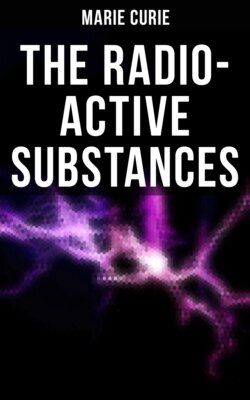Читать книгу Marie Curie: The Radio-Active Substances - Marie Curie - Страница 6
На сайте Литреса книга снята с продажи.
Radio-activity of the Compounds of Uranium and Thorium.
ОглавлениеTable of Contents
The following are the figures I obtained with different uranium compounds. I have represented the intensity of the current in ampères by the letter i:—
| i × 1011. | |
|---|---|
| Metallic uranium (containing a little carbon) | 2·3 |
| Black oxide of uranium, U2O5 | 2·6 |
| Green oxide of uranium, U3O4 | 1·8 |
| Hydrated uranic acid | 0·6 |
| Uranate of sodium | 1·2 |
| Uranate of potassium | 1·2 |
| Uranate of ammonium | 1·3 |
| Uranium sulphate | 0·7 |
| Sulphate of uranium and potassium | 0·7 |
| Nitrate of uranium | 0·7 |
| Phosphate of copper and uranium | 0·9 |
| Oxysulphide of uranium | 1·2 |
The thickness of the layer of the uranium compound used has little effect, provided that the layer is uniform. The following illustrate this point:—
| Thickness of layer. M.m. | i × 1011. | |
|---|---|---|
| Uranium oxide | 0·5 | 2·7 |
| Uranium oxide | 3·0 | 3·0 |
| Ammonium uranate | 0·5 | 1·3 |
| Ammonium uranate | 3·0 | 1·4 |
It may be concluded from this that the absorption of uranium rays by the substance which generates them is very great, since the rays proceeding from deep layers produce no significant effect.
The figures I obtained with thorium compounds enable me to state:—
Firstly, that the thickness of the layer used has considerable effect, especially in the case of the oxide.
Secondly, that the action is only regular if a sufficiently thin layer is used (e.g., 0·25 m.m.). On the contrary, when a thick layer of the substance is used (6 m.m.), the figures obtained vary between two extreme limits, especially in the case of the oxide:—
| Thickness of layer. M.m. | i × 1011. | |
|---|---|---|
| Thorium oxide | 0·25 | 2·2 |
| Thorium oxide | 0·5 | 2·5 |
| Thorium oxide | 2·5 | 4·7 |
| Thorium oxide | 3·0 | 5·5 (mean) |
| Thorium oxide | 6·0 | 5·5 (mean) |
| Thorium sulphate | 0·25 | 0·8 (mean) |
There is here some cause of irregularities which do not exist in the case of the uranium compounds. The figures obtained for a layer of oxide 6 m.m. thick varied between 3·7 and 7·3.
The experiments that I made on the absorption of uranium and thorium rays showed that those of thorium are more penetrating than those of uranium, and that the rays emitted by the oxide of thorium in a thick layer are more penetrating than those emitted by a thin layer of the same. The following figures (p. 13) give the fraction of the radiation transmitted by a sheet of aluminium 0·01 thick.
With the uranium compounds, the absorption is the same whatever be the compound used, which leads to the conclusion that the rays emitted by the different compounds are of the same nature.
| Radio-active substance. | Fraction of radiation transmitted by the sheet. |
|---|---|
| Uranium | 0·18 |
| Uranium oxide, U2O5 | 0·20 |
| Uranate of ammonium | 0·20 |
| Phosphate of uranium and copper | 0·21 |
| Thorium oxide of thickness 0·25 m.m. | 0·38 |
| Thorium oxide of thickness 0·5 m.m. | 0·47 |
| Thorium oxide of thickness 3·0 m.m. | 0·70 |
| Thorium oxide of thickness 0·60 m.m. | 0·70 |
| Thorium sulphate 0·25 m.m. | 0·38 |
The characteristics of the thorium radiation have formed the subject of very complete publications. Mr. Owens has demonstrated that a uniform current is only obtained after some time has elapsed, with an enclosed apparatus, and that the intensity of the current is greatly reduced under the influence of a current of air (which does not occur with the compounds of uranium). Mr. Rutherford has made similar experiments, and has explained them by the proposition that thorium and its compounds produce, besides the Becquerel rays, another emanation, composed of extremely minute particles, which remain radio-active for some time after their emission, and are capable of being swept along by a current of air.
The characteristics of the thorium radiation, which have reference to the thickness of the layer employed and to the action of air currents, have an intimate connection with the phenomenon of the radio-activity induced, and of its propagation from place to place. This phenomenon was observed for the first time with radium, and will be described later.
The radio-activity of thorium and uranium compounds appears as an atomic property. M. Becquerel has already observed that all uranium compounds are active, and had concluded that their activity was due to the presence of the element uranium; he also demonstrated that uranium was more active than its salts. I have investigated, from this point of view, the compounds of thorium and uranium, and have taken a great many measurements of their activity under different conditions. The result of all these determinations shows the radio-activity of these substances to be decidedly an atomic property. It seems to depend upon the presence of atoms of the two elements in question, and is not influenced by any change of physical state or chemical decomposition. The chemical combinations and mixtures containing uranium or thorium are active in proportion to the amount of the metal contained, all inactive material acting as inert bodies and absorbing the radiation.
